check engine Acura TSX 2011 Owner's Guide
[x] Cancel search | Manufacturer: ACURA, Model Year: 2011, Model line: TSX, Model: Acura TSX 2011Pages: 324, PDF Size: 7.85 MB
Page 286 of 324

285
Continued
Handling the Unexpected
Battery performance degrades in cold conditions
and may prevent the engine from starting. Jump Starting
5. Connect the other end of the second
jumper cable:
4 -cylinder models with automatic transmission
Engine mounting bolt
4 -cylinder models with manual transmission
Transmission mounting bolt
6-cylinder models
Engine hanger
Do not connect this jumper cable to any
other part of the engine.
6. If your vehicle is connected to another
vehicle, start the assisting vehicle's engine
and increase its rpm slightly.
7. Attempt to start your vehicle's engine. If
it turns over slowly, check that the jumper
cables have good metal-to-metal contact.
Jump Starting
6-cylinder models 4-cylinder models with
automatic transmission 4-cylinder models with
manual transmissionBooster Battery
Page 290 of 324
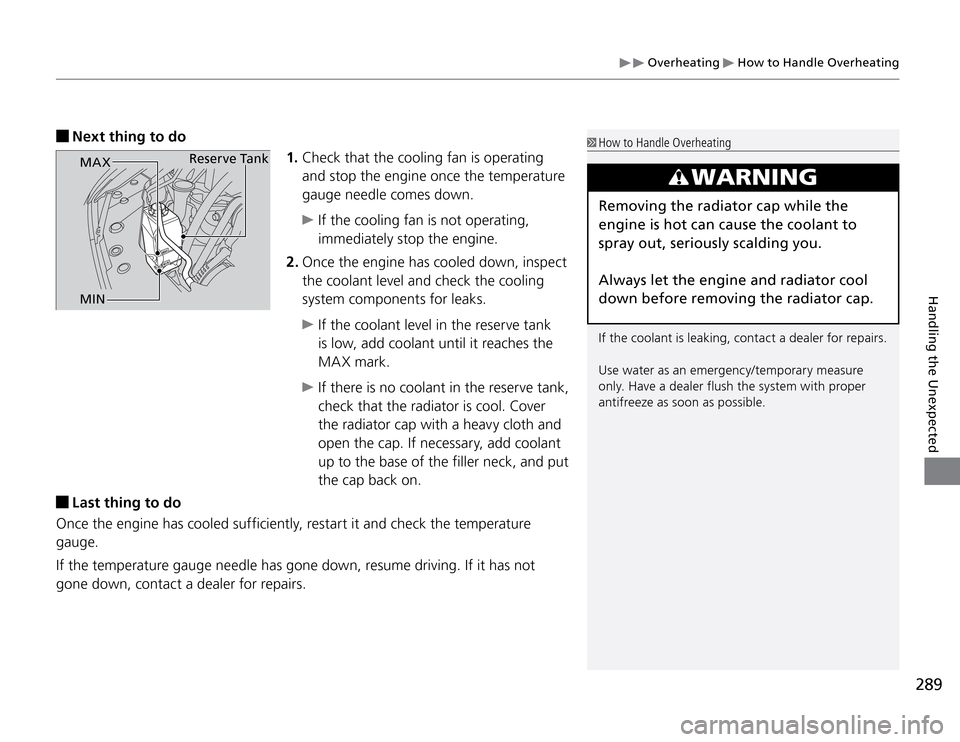
Overheating
How to Handle Overheating
289
Handling the Unexpected
Last thing to do
Once the engine has cooled sufficiently, restart it and check the temperature
gauge.
If the temperature gauge needle has gone down, resume driving. If it has not
gone down, contact a dealer for repairs.
How to Handle Overheating
If the coolant is leaking, contact a dealer for repairs.
Use water as an emergency/temporary measure
only. Have a dealer flush the system with proper
antifreeze as soon as possible.
Next thing to do
1. Check that the cooling fan is operating
and stop the engine once the temperature
gauge needle comes down.
If the cooling fan is not operating,
immediately stop the engine.
2. Once the engine has cooled down, inspect
the coolant level and check the cooling
system components for leaks. If the coolant level in the reserve tank
is low, add coolant until it reaches the
MA X mark. If there is no coolant in the reserve tank,
check that the radiator is cool. Cover
the radiator cap with a heavy cloth and
open the cap. If necessary, add coolant
up to the base of the filler neck, and put
the cap back on.
WARNING
Removing the radiator cap while the
engine is hot can cause the coolant to
spray out, seriously scalding you.
Always let the engine and radiator cool
down before removing the radiator cap.
Reserve Tank
MAX
MIN
Page 291 of 324
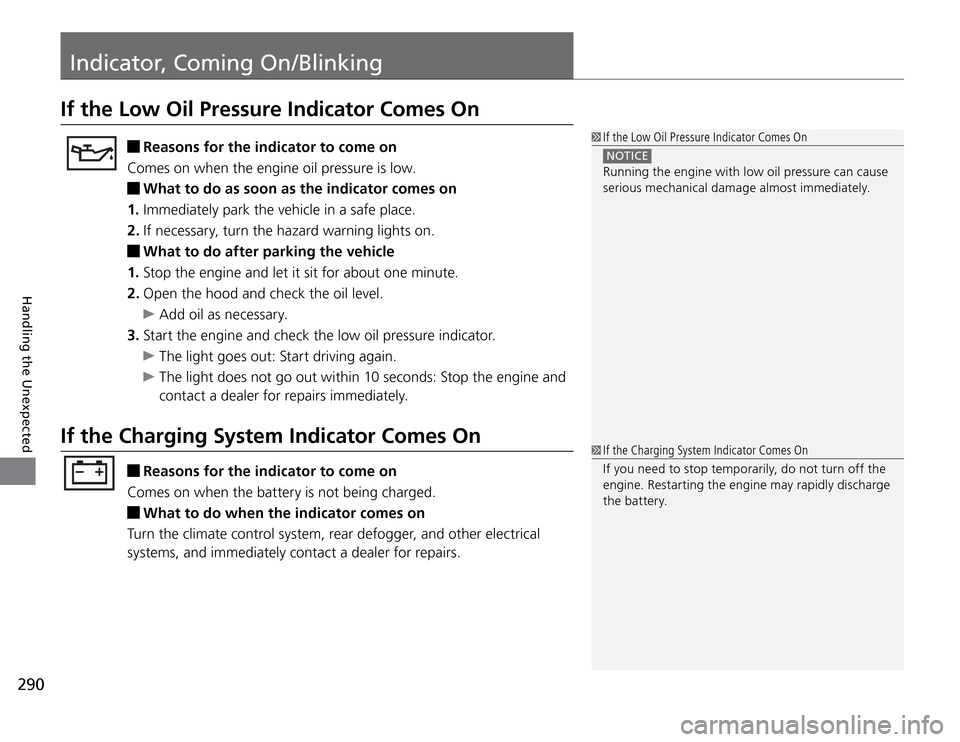
Indicator, Coming On/Blinking
290Handling the Unexpected
If the Low Oil Pressure Indicator Comes On
Reasons for the indicator to come on
Comes on when the engine oil pressure is low. What to do as soon as the indicator comes on
1. Immediately park the vehicle in a safe place.
2. If necessary, turn the hazard warning lights on. What to do after parking the vehicle
1. Stop the engine and let it sit for about one minute.
2. Open the hood and check the oil level.
Add oil as necessary.
3. Start the engine and check the low oil pressure indicator. The light goes out: Start driving again. The light does not go out within 10 seconds: Stop the engine and
contact a dealer for repairs immediately.
If the Charging System Indicator Comes On
Reasons for the indicator to come on
Comes on when the battery is not being charged. What to do when the indicator comes on
Turn the climate control system, rear defogger, and other electrical
systems, and immediately contact a dealer for repairs.
If the Low Oil Pressure Indicator Comes On NOTICE Running the engine with low oil pressure can cause
serious mechanical damage almost immediately. If the Charging System Indicator Comes On
If you need to stop temporarily, do not turn off the
engine. Restarting the engine may rapidly discharge
the battery.
Page 292 of 324

Indicator, Coming On/Blinking
If the Malfunction Indicator Lamp Comes On or Blinks
291
Handling the Unexpected
If the Malfunction Indicator Lamp Comes On or
Blinks
If the Malfunction Indicator Lamp Comes On or Blinks NOTICE If you drive with the malfunction indicator lamp on,
the emissions control system and the engine could
be damaged.
If the malfunction indicator lamp blinks again when
restarting the engine, drive to the nearest dealer
at 31 mph (50 km/h) or less. Have your vehicle
inspected.
Reasons for indicator lamp to come on or blink
Comes on when there is a problem with the engine emissions control �t
system, or the fuel fill cap is missing, or loose.
Blinks when engine misfiring is detected. �t What to do when the indicator lamp comes on
Avoid high speeds and immediately get your vehicle inspected at your
dealer. What to do when the indicator lamp blinks
Park the vehicle in a safe place with no flammable items and wait at
least ten minutes or more with the engine stopped until it cools.
Tighten Fuel Fill Cap Message The message appears on when:
An evaporative system leak is detected. This may be caused by the fuel fill cap
being loose or not being installed. What to do when the message appears:
1. Stop the engine.
2. Check that the fuel fill cap is fully installed.
If not, loosen the cap, and then retighten it until it clicks at least once.
3. Drive for several days of normal driving.
The message should go off.
When the malfunction indicator lamp comes on:
Malfunction indicator lamp comes on if the system continues to detect a leak
of gasoline vapor. If this happens, check the fuel fill cap using the procedures
described above.
Page 293 of 324

Indicator, Coming On/Blinking
If the Brake System Indicator Comes On
292Handling the Unexpected
If the Brake System Indicator Comes On
Reasons for the indicator to come on
The brake fluid is low. �t
There is a malfunction in the brake system. �t What to do when the indicator comes on while driving
Press the brake pedal lightly to check pedal pressure.
If normal, check the brake fluid level the next time you stop. �t
If abnormal, take immediate action. If necessary, downshift the �t
transmission to slow the vehicle using engine braking.
If the Brake System Indicator Comes On
Have your vehicle repaired immediately.
It is dangerous to drive with low brake fluid. If
there is no resistance from the brake pedal, stop
immediately in a safe place. If necessary downshift
the gears.
If the brake system indicator and ABS indicator
come on simultaneously, the brake distribution
system is not working. This can result in vehicle
instability under sudden braking.
Have your vehicle inspected by a dealer immediately.
U.S.
CanadaIf the EPS Indicator Comes On
Reasons for the indicator to come on
Comes on when there is a problem with EPS. �t
If you depress the accelerator pedal repeatedly to increase the �t
engine speed while the engine is idling, the indicator comes on, and
sometimes the steering wheel becomes harder to operate. What to do when the indicator comes on
Stop the vehicle in a safe place and restart the engine.
If the indicator comes on and stays on, immediately have your vehicle
inspected by a dealer.
If the EPS Indicator Comes On NOTICE If you repeatedly turn the steering wheel at an
extremely low speed, or hold the steering wheel
on the full left or right position for a while, the
system heats up. The system goes into a protective
mode, and limits its performance. The steering
wheel becomes harder and harder to operate. Once
the system cools down, EPS is restored. Repeated
operation under these conditions can eventually
damage the system.
Page 295 of 324
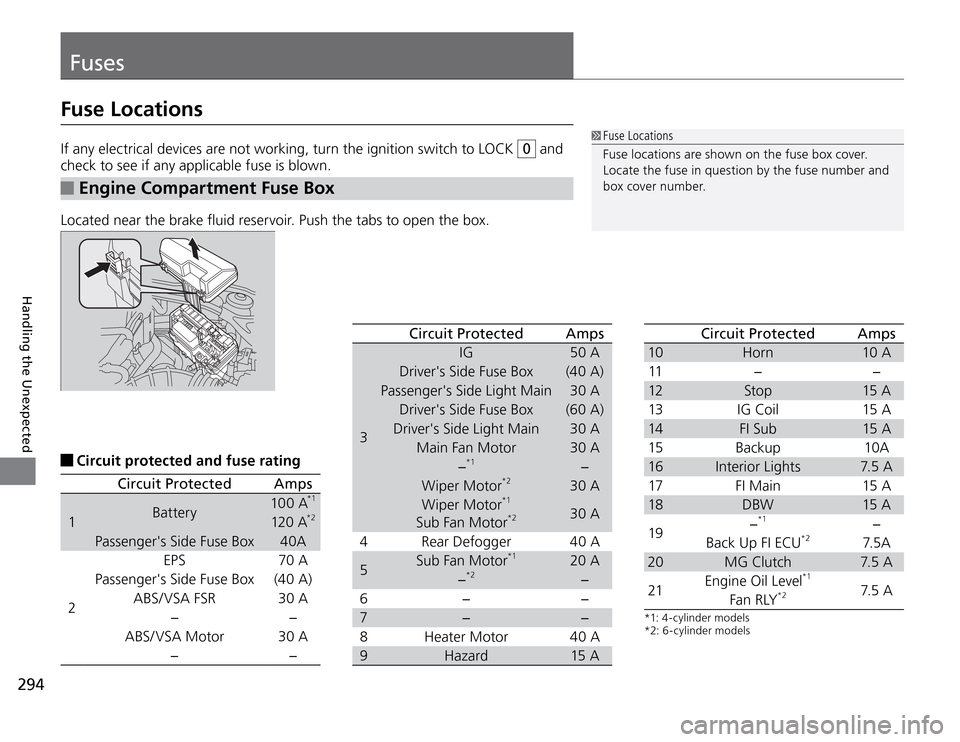
Fuses
294Handling the Unexpected
If any electrical devices are not working, turn the ignition switch to LOCK 0
and
check to see if any applicable fuse is blown.
Engine Compartment Fuse Box
Located near the brake fluid reservoir. Push the tabs to open the box.
Fuse Locations
Fuse locations are shown on the fuse box cover.
Locate the fuse in question by the fuse number and
box cover number.
Circuit protected and fuse rating
Fuse Locations
Circuit Protected Amps
1Battery100 A
*1
120 A
*2
Passenger's Side Fuse Box 40A
2EPS 70 A
Passenger's Side Fuse Box (40 A)
ABS/ VSA FSR 30 A
−−
ABS/ VSA Motor 30 A
−−
Circuit Protected Amps
3IG 50 A
Driver's Side Fuse Box (40 A)
Passenger's Side Light Main 30 A
Driver's Side Fuse Box (60 A)
Driver's Side Light Main 30 A
Main Fan Motor 30 A
−
*1
−
Wiper Motor
*2
30 A
Wiper Motor
*1
Sub Fan Motor*2
30 A
4 Rear Defogger 40 A
5Sub Fan Motor
*1
20 A
−
*2
−
6− −
7− −
8 Heater Motor 40 A
9 Hazard 15 A
Circuit Protected Amps
10 H orn 10 A
11 − −
12 St o p 15 A
13 IG Coil 15 A
14 FI Sub 15 A
15 B a c ku p 10 A
16 Interior Lights 7.5 A
17 FI Main 15 A
18 DBW 15 A
19−
*1
−
Back Up FI ECU
*2
7. 5 A
20 MG Clutch 7.5 A
21Engine Oil Level
*1
7.5 A
Fan RLY
*2
*1: 4-cylinder models
*2: 6 -cylinder models
Page 298 of 324
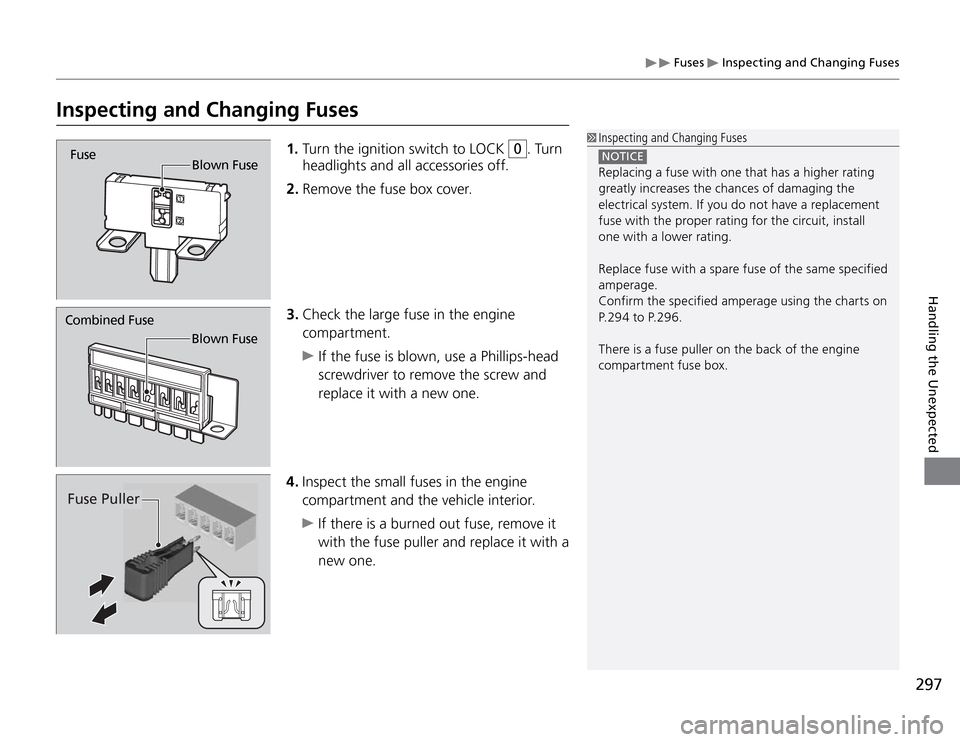
Fuses
Inspecting and Changing Fuses
297
Handling the Unexpected
Inspecting and Changing Fuses
1. Turn the ignition switch to LOCK 0
. Turn
headlights and all accessories off.
2. Remove the fuse box cover.
3. Check the large fuse in the engine
compartment.
If the fuse is blown, use a Phillips-head
screwdriver to remove the screw and
replace it with a new one.
Blown Fuse
Fuse
Blown Fuse
Combined Fuse
Inspecting and Changing Fuses NOTICE Replacing a fuse with one that has a higher rating
greatly increases the chances of damaging the
electrical system. If you do not have a replacement
fuse with the proper rating for the circuit, install
one with a lower rating.
Replace fuse with a spare fuse of the same specified
amperage.
Confirm the specified amperage using the charts on
P. 2 9 4 t o P. 2 9 6 .
There is a fuse puller on the back of the engine
compartment fuse box.
4. Inspect the small fuses in the engine
compartment and the vehicle interior.
If there is a burned out fuse, remove it
with the fuse puller and replace it with a
new one.
Fuse Puller
Page 310 of 324

309
Emissions Testing
Continued
Information
Your vehicle uses "readiness codes," as part of it's onboard self diagnostic system.
Some states refer to these codes during testing to see if your vehicle's emissions
components are working properly.
The codes may not be read if you go through the testing just after the battery has
gone dead or been disconnected.
To check if they are set, turn the ignition switch to ON
II
, without starting the
engine. The malfunction indicator lamp will come on for several seconds. If it then
goes off, the readiness codes are set. If it blinks five times, the readiness codes are
not set.
If you are required to have your vehicle tested before the readiness codes are
ready, prepare the vehicle for retesting by doing the following:
1. Fill the gas tank to approximately 3/4 full.
2. Park the vehicle and leave the engine off for 6 hours or more.
3. Make sure the ambient temperature is between 40 °F and 95 °F (4 °C and 35
°C).
4. Start the engine without touching the accelerator pedal, and let it idle for 20
seconds.
5. Keep the vehicle in
P
(automatic transmission) or
N
(manual transmission).
Increase the engine speed to 2,000 rpm, and hold it there until the temperature
gauge rises to at least 1/4 of the scale (about 3 minutes).
6. Let the engine idle with your foot off the accelerator for 20 seconds.
Testing of Readiness Codes
The readiness codes are erased when the battery is
disconnected, and set again only after several days
of driving under a variety of conditions.
If a testing facility determines that the readiness
codes are not set, you may be requested to return
at a later date to complete the test.
If the testing facility determines the readiness codes
are still not set, see a dealer.
Testing of Readiness Codes
Page 316 of 324
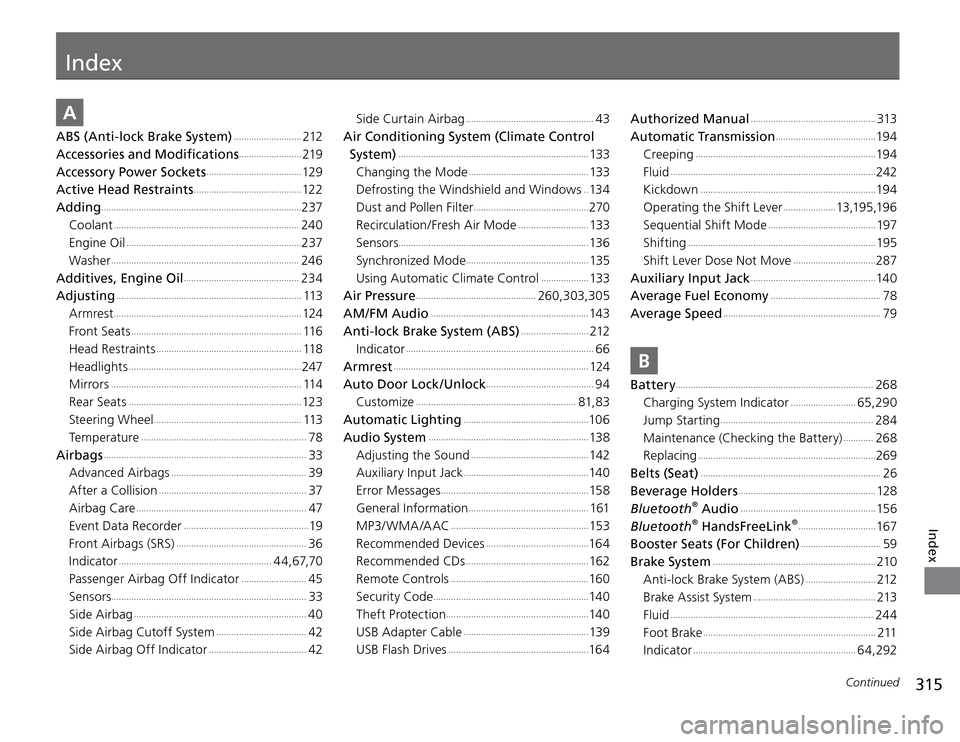
315
Continued
Index
Index
A ABS (Anti-lock Brake System)
...........................
212
Accessories and Modifications
.........................
219
Accessory Power Sockets
......................................
12 9
Active Head Restraints
...........................................
12 2
Adding
................................................................................
237
Coolant
..........................................................................
240
Engine Oil
......................................................................
237
Washer
...........................................................................
246
Additives, Engine Oil
..............................................
234
Adjusting
..........................................................................
113
Armrest
...........................................................................
124
Front Seats
....................................................................
11 6
Head Restraints
..........................................................
11 8
Headlights
.....................................................................
247
Mirrors
............................................................................
114
Rear Seats
.....................................................................
12 3
Steering Wheel
...........................................................
113
Temperature
..................................................................
78
Airbags
.................................................................................
33
Advanced Airbags
......................................................
39
After a Collision
...........................................................
37
Airbag Care
....................................................................
47
Event Data Recorder
..................................................
19
Front Airbags (SRS)
....................................................
36
Indicator
.............................................................
44,67,70
Passenger Airbag Off Indicator
..........................
45
Sensors
..............................................................................
33
Side Airbag
.....................................................................
40
Side Airbag Cutoff System
....................................
42
Side Airbag Off Indicator
.......................................
42Side Curtain Airbag
...................................................
43
Air Conditioning System (Climate Control
System)
............................................................................
133
Changing the Mode
................................................
133
Defrosting the Windshield and Windows ..13 4
Dust and Pollen Filter
..............................................
270
Recirculation/Fresh Air Mode
............................
133
Sensors
............................................................................
13 6
Synchronized Mode
.................................................
135
Using Automatic Climate Control
...................
133
Air Pressure
................................................
260,303,305
AM/FM Audio
...............................................................
143
Anti-lock Brake System (ABS)
...........................
212
Indicator
...........................................................................
66
Armrest
..............................................................................
124
Auto Door Lock /Unlock
...........................................
94
Customize
................................................................
81,83
Automatic Lighting
..................................................
10 6
Audio System
................................................................
13 8
Adjusting the Sound
...............................................
142
Auxiliary Input Jack
..................................................
14 0
Error Messages
...........................................................
15 8
General Information
................................................
161
MP3/ WMA /AAC
.......................................................
153
Recommended Devices
.........................................
16 4
Recommended CDs
.................................................
162
Remote Controls
.......................................................
16 0
Security Code
..............................................................
14 0
Theft Protection
.........................................................
14 0
USB Adapter Cable
..................................................
13 9
USB Flash Drives
........................................................
16 4
Authorized Manual
..................................................
313
Automatic Transmission
........................................
19 4
Creeping
........................................................................
19 4
Fluid
..................................................................................
242
Kickdown
......................................................................
19 4
Operating the Shift Lever
.....................
13 ,19 5 ,19 6
Sequential Shift Mode
...........................................
197
Shifting
...........................................................................
195
Shift Lever Dose Not Move
.................................
287
Auxiliary Input Jack
..................................................
14 0
Average Fuel Economy
............................................
78
Average Speed
...............................................................
79
BBattery
...............................................................................
268
Charging System Indicator
..........................
65,290
Jump Starting
.............................................................
284
Maintenance (Checking the Battery)
............
268
Replacing
.......................................................................
269
Belts (Seat)
........................................................................
26
Beverage Holders
.......................................................
128
Bluetooth
® Audio
......................................................
15 6
Bluetooth
® HandsFreeLink
® ...............................
167
Booster Seats (For Children)
................................
59
Brake System
.................................................................
210
Anti-lock Brake System (ABS)
............................
212
Brake Assist System
.................................................
213
Fluid
.................................................................................
24 4
Foot Brake
.....................................................................
211
Indicator
.................................................................
64,292
Page 318 of 324
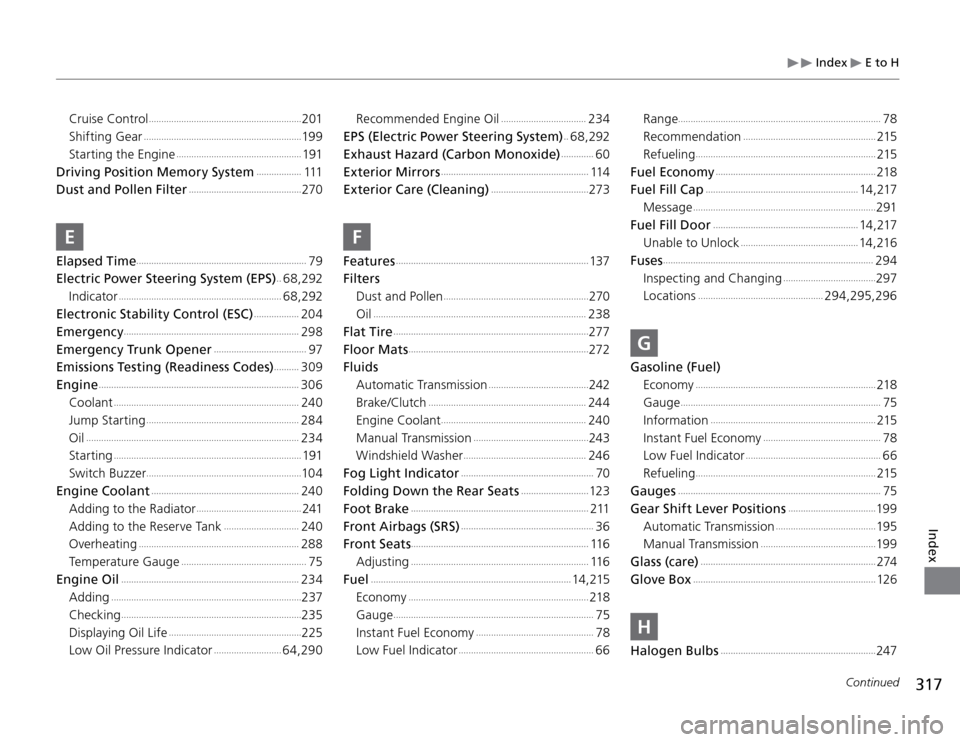
317
Index
E to H
Continued
Index
Cruise Control
.............................................................
201
Shifting Gear
...............................................................
19 9
Starting the Engine
..................................................
191
Driving Position Memory System
..................
111
Dust and Pollen Filter
.............................................
270
EElapsed Time
....................................................................
79
Electric Power Steering System (EPS)
..68,292
Indicator
.................................................................
68,292
Electronic Stability Control (ESC)
..................
204
Emergency
......................................................................
298
Emergency Trunk Opener
.....................................
97
Emissions Testing (Readiness Codes)
..........
309
Engine
................................................................................
306
Coolant
..........................................................................
240
Jump Starting
.............................................................
284
Oil
.....................................................................................
234
Starting
...........................................................................
191
Switch Buzzer
..............................................................
10 4
Engine Coolant
...........................................................
240
Adding to the Radiator
..........................................
241
Adding to the Reserve Tank
..............................
240
Overheating
................................................................
288
Temperature Gauge
..................................................
75
Engine Oil
.......................................................................
234
Adding
............................................................................
237
Checking
........................................................................
235
Displaying Oil Life
.....................................................
225
Low Oil Pressure Indicator
...........................
64,290
Recommended Engine Oil
..................................
234
EPS (Electric Power Steering System)
..68,292
Exhaust Hazard (Carbon Monoxide) .............
60
Exterior Mirrors
...........................................................
114
Exterior Care (Cleaning)
.......................................
273
FFeatures
.............................................................................
137
Filters
Dust and Pollen
..........................................................
270
Oil
.....................................................................................
238
Flat Tire
..............................................................................
277
Floor Mats
........................................................................
272
Fluids
Automatic Transmission
........................................
242
Brake/Clutch
...............................................................
24 4
Engine Coolant
..........................................................
240
Manual Transmission
..............................................
243
Windshield Washer
.................................................
246
Fog Light Indicator
.....................................................
70
Folding Down the Rear Seats
...........................
12 3
Foot Brake
.......................................................................
211
Front Airbags (SRS)
.....................................................
36
Front Seats
.......................................................................
11 6
Adjusting
.......................................................................
11 6
Fuel
................................................................................
14 , 215
Economy
........................................................................
218
Gauge
................................................................................
75
Instant Fuel Economy
...............................................
78
Low Fuel Indicator
......................................................
66
Range
.................................................................................
78
Recommendation
.....................................................
215
Refueling
........................................................................
215
Fuel Economy
................................................................
218
Fuel Fill Cap
.............................................................
14 , 217
Message
.........................................................................
291
Fuel Fill Door
..........................................................
14 , 217
Unable to Unlock
...............................................
14 , 216
Fuses
....................................................................................
294
Inspecting and Changing
.....................................
297
Locations
..................................................
294,295,296
GGasoline (Fuel)
Economy
........................................................................
218
Gauge
................................................................................
75
Information
..................................................................
215
Instant Fuel Economy
...............................................
78
Low Fuel Indicator
......................................................
66
Refueling
........................................................................
215
Gauges
.................................................................................
75
Gear Shift Lever Positions
...................................
19 9
Automatic Transmission
........................................
195
Manual Transmission
..............................................
19 9
Glass (care)
......................................................................
274
Glove Box
.........................................................................
126
HHalogen Bulbs
..............................................................
247